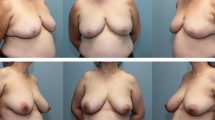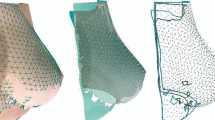Abstract
Background
Different procedures are available to help clinicians evaluate symmetry and cosmetic results in an objective manner after conservative breast cancer surgery. However, there are no similar methods in esthetic breast surgery, where the subjective assessment of the surgeon or the patient is usually considered the gold standard. The aim of this study is to evaluate the application of four software programs in the context of esthetic breast surgery and contrast their results with those of the subjective evaluation by a series of healthcare professionals.
Materials and Methods
Sixty cosmetic breast surgery images were studied using four software programs considered appropriate for the objective evaluation (BCCT3.core®, Breast Analyzing Tool®, Objective Breast Cosmesis Scale® and GBAI—Global Breast Asymmetry Index®). The same cases were assessed by a group of 100 health professionals through an online survey as a subjective evaluation method.
Results
Concordance among participants was high (κ = 0.753) as well as between three of the objective methods (BSI, OBCS, GBAI), but not with the BCCT parameter. There was no association between objective and subjective methods studied by the survey, according to the logistic regression model. The “symmetry” and “asymmetry” categories were accurately distinguished by the objective methods.
Conclusions
Objective evaluation in esthetic breast surgery has less variability than subjective assessment, and the estimation is possible through certain software previously restricted to conservative breast cancer surgery.
Level of Evidence IV
This journal requires that authors assign a level of evidence to each article. For a full description of these Evidence-Based Medicine ratings, please refer to the Table of Contents or the online Instructions to Authors www.springer.com/00266.






Similar content being viewed by others
References
ASPS—American Society of Plastic Surgeons (2018) 2018 plastic surgery statistics report. https://www.plasticsurgery.org/documents/News/Statistics/2018/plastic-surgery-statistics-full-report-2018.pdf. Accessed 17 Dec 2019
ISAPS—International Society of Aesthetic Plastic Surgery ISAPS International Survey on Aesthetic/Cosmetic Procedures 2018. https://www.isaps.org/wp-content/uploads/2019/12/ISAPS-Global-Survey-Results-2018-new.pdf. Accessed 28 Mar 2020
Cogliandro A, Brunetti B, Barone M et al (2018) Management of contralateral breast following mastectomy and breast reconstruction using a mirror adjustment with crescent mastopexy technique. Breast Cancer 25:94–99. https://doi.org/10.1007/s12282-017-0796-6
Cohen WA, Mundy LR, Ballard TNS et al (2016) The BREAST-Q in surgical research: a review of the literature 2009–2015. J Plast Reconstr Aesthet Surg 69:149–162. https://doi.org/10.1016/j.bjps.2015.11.013
Pezner RD, Lipsett JA, Vora NL, Desai KR (1985) Limited usefulness of observer-based cosmesis scales employed to evaluate patients treated conservatively for breast cancer. Int J Radiat Oncol Biol Phys 11:1117–1119. https://doi.org/10.1016/0360-3016(85)90058-6
Cai LZ, Paro JAM, Lee GK, Nazerali RS (2018) Where do we look? Assessing gaze patterns in breast reconstructive surgery with eye-tracking technology. Plast Reconstr Surg 141:331e–340e. https://doi.org/10.1097/PRS.0000000000004106
Swanson E (2012) A measurement system for evaluation of shape changes and proportions after cosmetic breast surgery. Plast Reconstr Surg 129:982–992. https://doi.org/10.1097/PRS.0b013e3182442290
Lewin R, Amoroso M, Plate N et al (2016) The aesthetically ideal position of the nipple-areola complex on the breast. Aesthet Plast Surg 40:724–732. https://doi.org/10.1007/s00266-016-0684-z
O’Connell RL, Di Micco R, Khabra K et al (2017) The potential role of three-dimensional surface imaging as a tool to evaluate aesthetic outcome after Breast Conserving Therapy (BCT). Breast Cancer Res Treat 164:385–393. https://doi.org/10.1007/s10549-017-4256-y
MacLatchie E Charfare H et al (2010) A comparison of different methods of assessing cosmetic outcome following breast-conserving surgery and factors influencing cosmetic outcome. Br J Medical Pract 3(1):310
Mikolajczyk M, Kasielska-Trojan A, Antoszewski B (2019) A new tool for breast anthropometric measurements: presentation and validation for women and men. Aesthet Plast Surg 43:1160–1170. https://doi.org/10.1007/s00266-019-01467-6
Monton J, Perez O, Dobon MM et al (2019) Breast asymmetry assessment using optical flow algorithms. Cir Plast Iberolatinoam 45:13. https://doi.org/10.4321/S0376-78922019000300007
Cardoso MJ, Cardoso J, Amaral N et al (2007) Turning subjective into objective: the BCCT.core software for evaluation of cosmetic results in breast cancer conservative treatment. Breast 16:456–461. https://doi.org/10.1016/j.breast.2007.05.002
Krois W, Romar AK, Wild T et al (2017) Objective breast symmetry analysis with the Breast Analyzing Tool (BAT): improved tool for clinical trials. Breast Cancer Res Treat 164:421–427. https://doi.org/10.1007/s10549-017-4255-z
Soror T, Lancellotta V, Kovács G et al (2019) kOBCS©: a novel software calculator program of the Objective Breast Cosmesis Scale (OBCS). Breast Cancer. https://doi.org/10.1007/s12282-019-01006-w
Sullivan GM, Artino AR (2013) Analyzing and interpreting data from Likert-type scales. J Grad Med Educ 5:541–542. https://doi.org/10.4300/JGME-5-4-18
Cardoso JS, Cardoso MJ (2007) Towards an intelligent medical system for the aesthetic evaluation of breast cancer conservative treatment. Artif Intell Med 40:115–126. https://doi.org/10.1016/j.artmed.2007.02.007
BCCT.core—Breast Research Group. http://medicalresearch.inescporto.pt/breastresearch/index.php/BCCT.core. Accessed 7 Aug 2019
Yu T, Eom K-Y, Jang NY et al (2016) Objective measurement of cosmetic outcomes of breast conserving therapy using BCCT.core. Cancer Res Treat 48:491–498. https://doi.org/10.4143/crt.2015.088
Simple OBCS Calculator. In: Breast symmetry tools. https://www.breastsymmetry.com/. Accessed 1 Nov 2019
Cardillo G (2018). Fleiss'es kappa: compute the Fleiss'es kappa for multiple raters. In: GitHub. https://www.github.com/dnafinder/Fleiss. Accessed 7 Feb 2019
Fleiss JL (1999) The design and analysis of clinical experiments, Wiley classics library edn. Wiley, New York
Mohan AT, Al-Ajam Y, Mosahebi A (2013) Trends in tertiary breast reconstruction: literature review and single centre experience. Breast 22:173–178. https://doi.org/10.1016/j.breast.2012.06.004
Atiyeh B, Chahine F (2018) Metrics of the aesthetically perfect breast. Aesthet Plast Surg. https://doi.org/10.1007/s00266-018-1154-6
Hall-Findlay EJ (2012) Discussion: a measurement system for evaluation of shape changes and proportions after cosmetic breast surgery. Plast Reconstr Surg 129:993. https://doi.org/10.1097/PRS.0b013e3182454377
Pietruski P, Paskal W, Paskal AM et al (2019) Analysis of the visual perception of female breast aesthetics and symmetry: an eye-tracking study. Plast Reconstr Surg 144:1257–1266. https://doi.org/10.1097/PRS.0000000000006292
Swanson E (2017) A measurement system and ideal breast shape. In: Swanson E (ed) Evidence-based cosmetic breast surgery. Springer International Publishing, Cham, pp 19–31. https://doi.org/10.1007/978-3-319-53958-4_2
Fitzal F, Krois W, Trischler H et al (2007) The use of a breast symmetry index for objective evaluation of breast cosmesis. Breast 16:429–435. https://doi.org/10.1016/j.breast.2007.01.013
Soror T, Kovács G, Kovács Á et al (2016) New objective method in reporting the breast cosmesis after breast-conservative treatment based on nonstandardized photographs: the Objective Breast Cosmesis Scale. Brachytherapy 15:631–636. https://doi.org/10.1016/j.brachy.2016.06.008
Liu LQ, Branford OA, Mehigan S (2018) BREAST-Q measurement of the patient perspective in oncoplastic breast surgery: a systematic review. Plast Reconstr Surg Glob Open 6:e1904. https://doi.org/10.1097/GOX.0000000000001904
Cardoso MJ, Cardoso JS, Wild T et al (2009) Comparing two objective methods for the aesthetic evaluation of breast cancer conservative treatment. Breast Cancer Res Treat 116:149–152. https://doi.org/10.1007/s10549-008-0173-4
Preuss J, Lester L, Saunders C (2012) BCCT.core—can a computer program be used for the assessment of aesthetic outcome after breast reconstructive surgery? Breast 21:597–600. https://doi.org/10.1016/j.breast.2012.05.012
Cardoso MJ, Cardoso J, Santos AC et al (2006) Interobserver agreement and consensus over the esthetic evaluation of conservative treatment for breast cancer. Breast 15:52–57. https://doi.org/10.1016/j.breast.2005.04.013
Brands-Appeldoorn ATPM, Maaskant-Braat AJG, Zwaans WAR et al (2018) Patient-reported outcome measurement compared with professional judgment of cosmetic results after breast-conserving therapy. Curr Oncol 25:e553–e561. https://doi.org/10.3747/co.25.4036
Henseler H, Smith J, Bowman A et al (2013) Subjective versus objective assessment of breast reconstruction. J Plast Reconstr Aesthet Surg 66:634–639. https://doi.org/10.1016/j.bjps.2013.01.006
Lancellotta V, Seipelt L, Hannoun-Levi J-M et al (2018) Multi-institutional evaluation of the reproducibility and the accuracy of the Objective Breast Cosmesis Scale. Brachytherapy 17:944–948. https://doi.org/10.1016/j.brachy.2018.07.016
Mallucci P, Branford OA (2014) Population analysis of the perfect breast: a morphometric analysis. Plast Reconstr Surg 134:436–447. https://doi.org/10.1097/PRS.0000000000000485
Overschmidt B, Qureshi AA, Parikh RP et al (2018) A prospective evaluation of three-dimensional image simulation: patient-reported outcomes and mammometrics in primary breast augmentation. Plast Reconstr Surg 142:133e–144e. https://doi.org/10.1097/PRS.0000000000004601
Henseler H (2011) Three-dimensional breast assessment by multiple stereophotogrammetry after breast reconstruction with latissimus dorsi flap. PhD thesis, University of Glasgow
Tzou C-HJ, Artner NM, Pona I et al (2014) Comparison of three-dimensional surface-imaging systems. J Plast Reconstr Aesthet Surg 67:489–497. https://doi.org/10.1016/j.bjps.2014.01.003
Funding
This research was exclusively privately funded.
Author information
Authors and Affiliations
Corresponding author
Ethics declarations
Conflict of interest
The authors declare that there is no conflict of interest regarding the publication of this article.
Ethical Standards
There was no direct intervention on patients. This study was part of a larger research that compares different methods of breast asymmetry assessment and it was approved by the ethical committee of Albacete University Hospital, Albacete, Spain, on March 2017.
Informed Consent
All participants provided informed consent.
Additional information
Publisher's Note
Springer Nature remains neutral with regard to jurisdictional claims in published maps and institutional affiliations.
Electronic supplementary material
Below is the link to the electronic supplementary material.
Supplementary material 1 (MOV 36692 kb)
Supplementary material 2 (M4V 28962 kb)
Supplementary material 3 (M4V 1872 kb)
Supplementary material 4 (M4V 9970 kb)
Rights and permissions
About this article
Cite this article
Monton, J., Torres, A., Gijon, M. et al. Use of Symmetry Assessment Methods in the Context of Breast Surgery. Aesth Plast Surg 44, 1440–1451 (2020). https://doi.org/10.1007/s00266-020-01755-6
Received:
Accepted:
Published:
Issue Date:
DOI: https://doi.org/10.1007/s00266-020-01755-6




